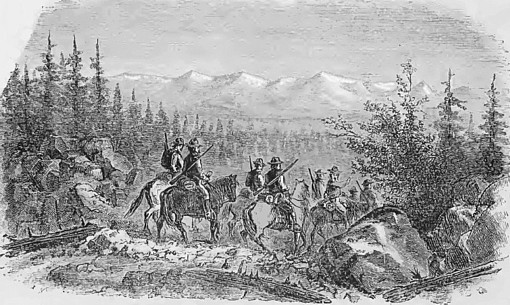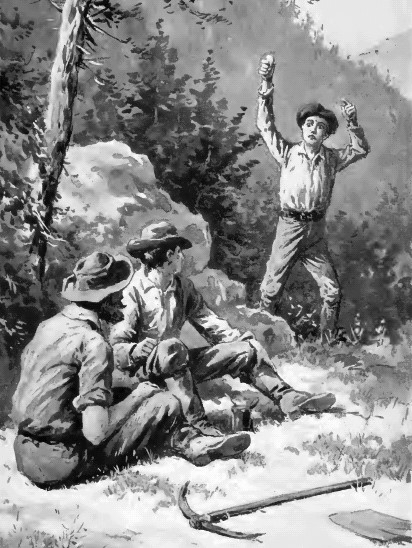The silver interests of the Black Hills, though started later than the gold mines, should not be overlooked. They give promise of great things for the future, and the discoveries now being made are of that importance which make this interest second to none in the Black Hills. The Bear Butte silver region and its city of Galena, a thrifty, growing town, will, in time, become a region of great importance. The first discovery of silver ore in the Black Hills was made in the Bear Butte District, some ten miles south-east of Deadwood, in 1877, by mere accident. A miner was out gold prospecting on a neighboring hillside, and came upon a large body of ore, which contained about twenty percent lead and a fair proportion of silver. About the same time another miner, who was sluicing in the gulch, found among his gold dust, one night, a native silver nugget of almost pure silver, which had evidently been washed down from some vein in the mountains above. These circumstances led to a search for that metal, and those who could content themselves with the less valuable silver ore found it in all directions. One of these silver ledges has been traced for five miles, and openings made upon the lead at various points nearly the whole distance. The Florence Silver Mine was located in 1877, and was purchased in 1879 by some St. Paul capitalists, who have erected a fine silver mill for the reduction of their ores. The mine is well developed by tunnels and drifts, and has in sight a large amount of ore, which averages from thirty to one hundred and fifty ounces of silver per ton, or about that many dollars. The mill reduces about twenty-five tons of ore per day, and the prospects of the company seem flattering. There is at Galena a small custom smelter, and other silver mines of great promise. The Florence mill is turning out pure silver bullion at the rate of about twenty-five thousand dollars per month, and has as fine machinery as can be found in the country. Each alternate day a brick is made, that weighs one thousand to one thousand three hundred ounces of silver. The mill is a twenty-stamp dry crusher, with two Bruckner cylinders, for roasting the ore.
The Florence Mill.
The mill is at the base of the hill, and on a line with the mouth of the tunnel. By means of a tramway and chute the ore will be dumped into the ore-room, where it is partially crushed by a Blake rock-breaker, from whence it goes to a drying cylinder and is thoroughly dried, and thence to the self-feeders, where it is fed into the stamps, and thence to the Bruckner cylinders, where the silver and lead, by this roasting process, is oxidized, the baser metals of arsenic, sulfur and antimony being separated, the silver and lead dust thence passing to mortars and concentrating pans. The mill cost about eighty thousand dollars. In the Galena silver region the stratification of the county rock lies horizontal, the formation being granite and porphyry, capped with limestone and quartzite.
Most of the work has been done in the quartzite, where rich horn silver chlorides, sulfides and carbonates of silver outcropped at the surface, in the form of "chutes" or "chimneys." These have been followed by tunnels, whereas, had the quartzite been pierced by shafts until the primitive formation of granite was reached, it is probable that a "deposit" or a contact vein of ore would have been exposed. However, there are a number of true fissure veins in the district with well-defined walls. Mr. Robert Floorman, the superintendent, and we believe, 'discoverer of the Florence mine, has driven a tunnel into the mountain a depth of over six hundred feet, and is not far from the granite formation of the main hill, the indications near the end of the tunnel point to the theory of a large deposit of ore.
The numerous "pockets," filled with chloride and sulfides of silver, are more frequent and larger, while the pay streak is taking a downward dip toward the centre of the hill, where it will probably take the granite for its footwall. The superintendent had about one thousand tons of ore on the dump, graded as first, second and third class. The first class assays about one thousand dollars, and the third-class ore about thirty dollars per ton. Another silver mill, called "McDonald's Furnace," is in the district, and is pronounced a good one, and is a custom smelter. The most prominently developed mines, besides the Florence, are the "El Refugio," the "Meritt, No. 1," "Meritt, No. 2," the "General Custer," "Spotted Tail," "Buckeye," "Sitting Bull" and "Crestline." What is needed in the district is more custom smelting works, or a sampling and ore-buying company, so that the miners can sell their ore as fast as extracted. Many of the miners have several tons of high-grade ore on . their dumps, on which they would be unable to get a sack of flour.
The Cora Mine, at Galena, in which a recent rich strike was made, is on the same vein as " Meritt Nos. 1 and 2," "R. B. Hayes," "Sitting Bull," and others. This vein is opened every three or four hundred feet for three miles. Assays have been made from the Cora, showing an average of twelve thousand dollars to the ton, in one instance. The mine was located in 1876, and considerable work was done at various points, showing large bodies of galena, or chiefly lead ore ; but it was only lately, while a new shaft was being sunk, that anything like the value of the property was known to its owners. Then near the surface they encountered a body of decomposed Galena, mingled with black sulfate, in which native silver could readily be seen. Reports of the discovery spread like wildfire throughout that and adjoining camps, and the greatest level of gold rush excitement prevailed. The lucky owners of this Bonanza are W. W. Andrews, P. Donovan and J. McNamee. The vein proper has a width of about four feet, but the rich carbonate streak above alluded to is only about eighteen inches across. It is impossible, at this early date, to give, any correct estimate as to the future value of this mine. It would be the exception, and not the rule, for the mine to produce ore of such great richness in any considerable quantities ; and although the mine may be in fact a regular "Bonanza," it is more than probable that this rich pocket of ore will soon be exhausted. There is also a gold district in the vicinity of Galena City, in which much activity is being shown. The "Boss Tweed" mine is down one hundred and twenty-five feet in ore, which assays well in gold. The "Golden Prize" mine is in the same location.
Return
to The South Dakota Page:
South Dakota Gold Rush History



